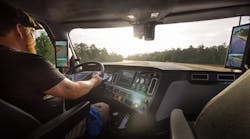One of the next significant advancements in video technology could spell the end of vehicle mirrors as we know them.
The National Highway Traffic Safety Administration (NHTSA) is considering allowing a camera monitor system, or CMS, to replace rearview and sideview mirrors on commercial trucks.
Currently, the MirrorEye CMS from Stoneridge is the only system that has received an exemption from the Federal Motor Carrier Safety Administration. However, trucks using the system still legally need traditional mirrors.
More than 100 trucks from over a dozen fleets are using MirrorEye, the company said. Stoneridge hopes the system will be factory-installed on the vehicles of at least two manufacturers by the middle of this decade.
The MirrorEye system equips a vehicle with five cameras, sensors and three digital displays inside the cab in the form of two 12-in. vertical monitors attached to the A-pillars on both sides. It also adds a 7-in. screen that mounts high in the center of the cab — like a smaller vehicle’s rearview mirror.
The cameras are mounted on the exterior of the vehicle, near where traditional rearview mirrors are, to provide a similar field of view. Stoneridge says its CMS delivers a 25% larger field of view that eliminates common blind spots.
Separately, Bosch has teamed up with Mekra Lang to develop a digital mirror system for commercial vehicles. The system replaces the large side mirrors — typically 50 sq. in. — with two interior monitors and two external cameras above the driver’s cab. According to Bosch, the aerodynamic design reduces fuel consumption by as much as 2%.
Bosch showed off its CMS at the North American Commercial Vehicle Show last fall, where it equipped a Freightliner Cascadia and Nikola Two with the system.
“Here we talk about the implementation of digital mirror systems that are using cameras with increased optic capabilities to not only make the job less stressful but make it safer,” said Jason Roycht, vice president and regional business unit leader of commercial vehicles & off-road for Bosch in North America.
NHTSA has said that such a system could come with safety benefits, such as improved situational awareness for truck drivers that would lead to reduced sideswipes. Researchers have surveyed commercial drivers using supplemental CMS and found neutral and potentially positive findings concerning safety-critical events and drivers’ forward attention, according to NHTSA.
There are potential safety concerns and challenges. For example, drivers indicated that the glare produced from the system’s electronic visual displays was “too bright and affected their ability to see details in the forward roadway” and that “glare from the visual displays could be uncomfortable at night.”
In 2015, the German Federal Highway Research Institute published a study that compared outside rearview mirrors with a CMS display in heavy trucks (and passenger vehicles) under various testing conditions. The study concluded that a CMS that meets “specific quality criteria” can provide “sufficient” rear visibility for drivers. The study also found that the change from outside rearview mirrors to a CMS requires a period of driver familiarization that is “relatively short.”




